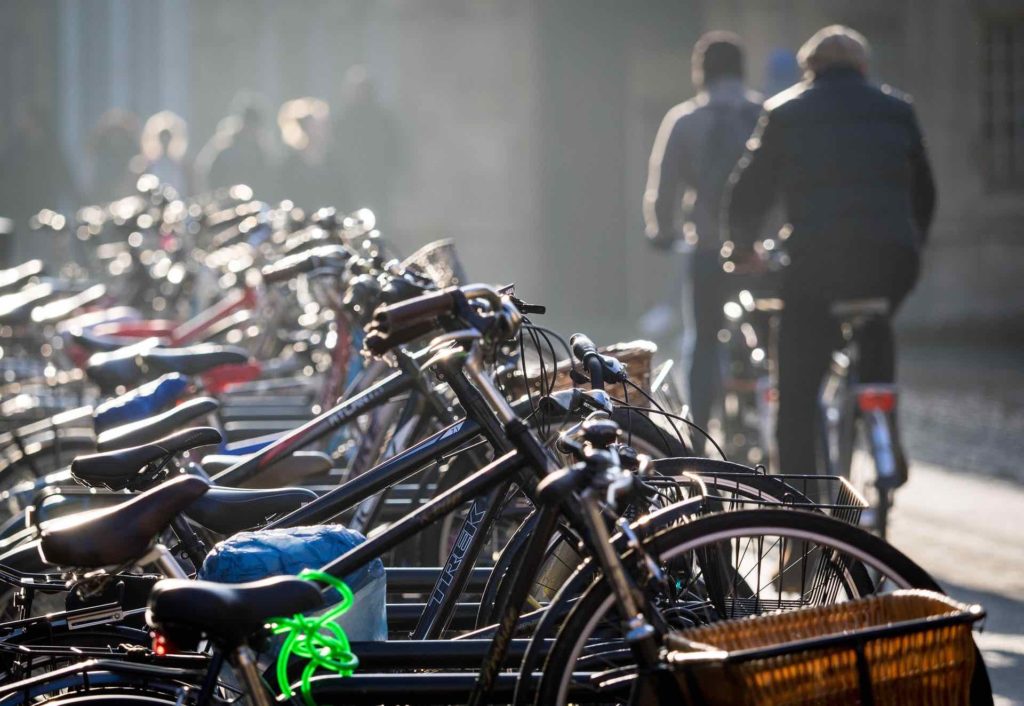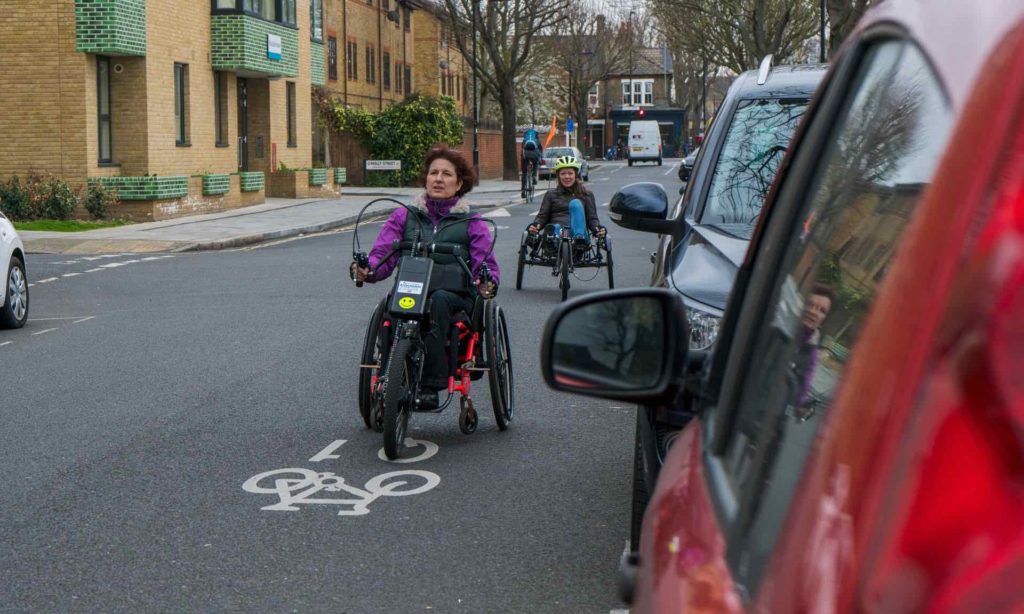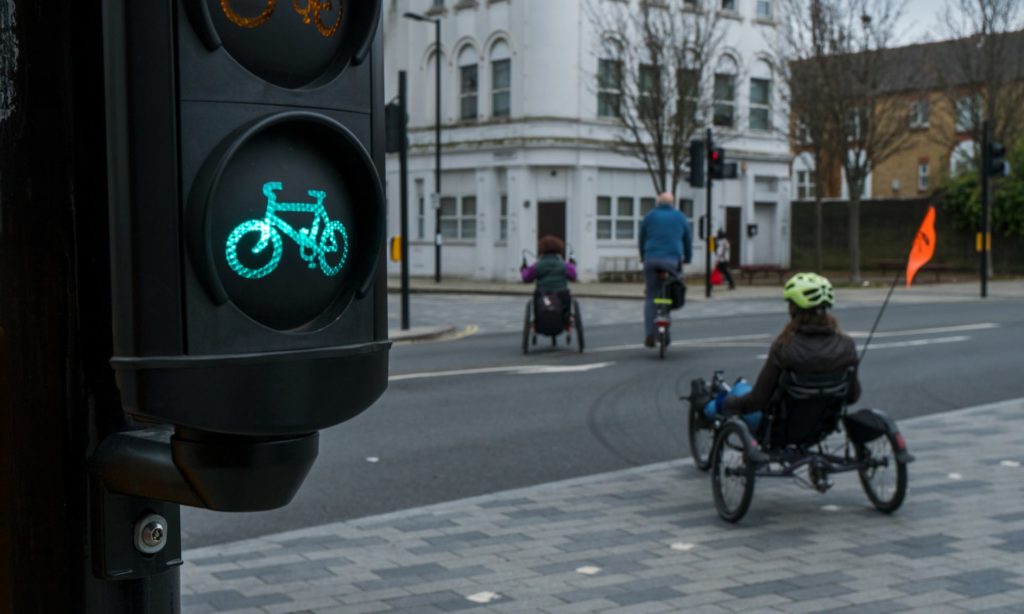Riding a bike may be easier than walking for two-thirds of disabled cyclists, but they often remain invisible to society. Many don’t realise that more than a quarter of disabled commutes in this university city are made by bike.
Cycle around Cambridge and you’ll see upright city bikes and hybrids, tricycles and four-wheeled cargo bikes. What may be surprising is that many of these machines are used as mobility aids: more than a quarter of disabled people’s commutes here are by bike.
In the context of an ageing global population, mobility experts are increasingly seeing cycling as a way to help people with disabilities move around cities independently. A bike can act as a “rolling walking stick”; yet looking at its owner you wouldn’t know they had a disability: around 40% of disabled cyclists simply use a regular two-wheeled bike.
For two out of three disabled cyclists, riding a bike is easier than walking, easing joint strain, aiding balance and relieving breathing difficulties. According to recent research by Transport for London, 78% of disabled people are able to cycle, while 15% sometimes use a bike to get around.
From our partners:
“The biggest determinant of how many disabled people cycle to work is how levels of broader cycling are within that local authority,” says Rachel Aldred, reader in transport at the University of Westminster, who has researched barriers to disabled cycling.
In Cambridge, where 26% of disabled people’s commutes are by bike, cycling’s total share of trips to work is 32% – the highest of any city in Britain.
In cities with low overall cycle commuting levels of 0.4 or 0.5%, the figure for disabled cycle commutes would typically be just 0.2%. “I think that shows you there’s not some inherent limitation [for disabled cyclists],” she says. “It depends on how cycling-friendly the places are in general.”

Isabelle Clement is the director of Wheels for Wellbeing, a UK-based charity that encourages and supports disabled cycling. She says her life was transformed once she adapted her own wheelchair as a hand cycle. Many disabled people rule cycling out as an option, without realising the wide variety of machines that are out there for a range of different needs, she says.
Active travel can tackle inactivity, isolation, mental health issues and reliance on expensive private transportation such as taxis; yet disabled people are more likely to be inactive than non-disabled people (37.8% in Britain compared with 18.2%, according to Public Health England). Reduced transport options are also a common barrier to accessing work, healthcare and a social life.
False assumptions
Research shows that minority ethnic people, women, older and disabled people have a disproportionately higher need for protected cycling infrastructure and direct routes – something Wheels for Wellbeing seeks to address in its new Guide to Inclusive Cycling.
Part of the problem is that most urban infrastructure is built by able-bodied engineers, who may not realise that bollards, speed bumps, kerbs and steps can be insurmountable for disabled cyclists. Clement argues that cities should consult disability representatives at a strategic level.
“Cycling facilities are built on the assumption we can all stand up,” says Clement. “That cyclists all ride on two wheels, that we can all lift our cycles, can carry our gear … otherwise how can we get over the steps on that bridge?”
Shared space – where pedestrians, cars and cyclists interact – can be difficult for visually impaired pedestrians and disabled cyclists. As Dr Jamie Wood, a biology lecturer at the University of York, explains: “I find shared space with pedestrians very intimidating as a disabled cyclist. I end up stopping in very random places and find it very difficult to get going again.”
The size and expense of specialised cycles is another factor. Narrow cycle lanes and chicanes are unusable for many non-standard bikes (side-by-side tandems can be more than a metre wide), while a third of disabled cyclists report being unable to park or store large bikes.

These bikes often cost as much as a secondhand car (tricycles can cost up to £3,000), an issue that can be addressed nationally with tax breaks such as the UK’s Green Commute Initiative, or at city level with accessible cycle hire.
After much criticism that its bike share scheme excluded disabled people, Portland, Oregon, piloted a programme called Adaptive Biketown in July – offering tandems, handcycles and tricycles for rent.
“I would urge every city to have at least one inclusive cycling hub,” says Clement. “That is the entry route to cycling for many disabled people and it’s a very clear signal by cities saying, ‘We believe that we should invest some of our public resources, in partnership with others, to ensure people have the option of cycling.’”
Although public transport may claim to be accessible, in practice this isn’t always the case. In Lisbon, buses have ample space for cycles, but in UK cities they don’t. Some trains can’t carry larger adaptive bikes, or don’t have a policy relating to disabled cyclists at all.
Meanwhile, those who do use bikes as mobility aids may be asked to dismount on pavements or station concourses, in the way someone with a wheelchair or mobility scooter wouldn’t be.
Cycling imagery and language often excludes disabled cyclists, say campaigners. Better representation, along with “disabled cyclists permitted”, or “cycles as mobility aids permitted” signage in otherwise non-cycling areas would help raise the profile of disabled cycling.
In January, London will launch a pilot scheme which recognises bikes as mobility aids, permitting disabled cyclists in pedestrian-only areas around the city.
“We don’t know how it will work,” says Will Norman, the city’s cycling and walking commissioner, “but we need to pilot this and take a step towards it. If the pilot is successful, [I’ll] share that data and the experience behind that with other cities so they can make up their own mind whether that works for them.”
Neil Andrews of Wheels for Wellbeing says there are “some examples of good facilities and infrastructure out there” but “by and large they are few and far between”. “Without consistently good inclusive infrastructure and facilities, disabled cyclists are unable to complete a journey,” he says. “That means many people simply won’t attempt a journey in the first place.”
Disabled people are the canary in the coalmine for healthy streets – if disabled people are using your streets in high numbers, you are doing something right.
This feature originally appeared in The Guardian.















